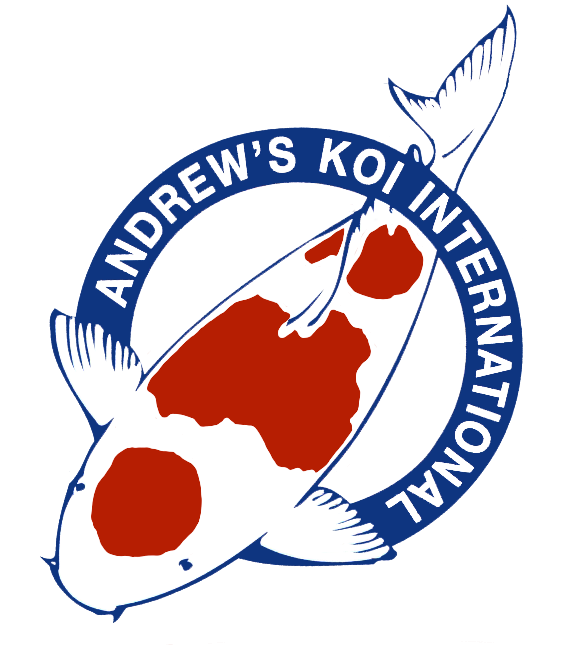Koi Buying Basic’s
by Ray Jordan
www.texaskoi.com
This article is meant to serve only as a basic guide. Each section that follows has been written to serve as an introduction to the topic and not a complete discussion. Joining a local koi club and becoming a subscriber to KOI USA magazine www.koiusa.com are some of the best investments you can make as a koi hobbyist to access the wealth of information available about keeping koi.
Buying Koi: Deal with experienced dealers with excellent reputations. Ask your club members for recommendations or ask hobbyists at shows with the type of koi you like where they were purchased. If possible buy koi in person so you can see them with your own eyes. Today’s high tech digital cameras often produce photos that look better than the koi in real life. Inquire about dealer quarantine procedures and testing. New hobbyists would be wise to ask a more experienced koi keeper to accompany them when buying koi. Koi are individually unique creatures and their value/pricing depends on many factors including but not limited to dealer/breeder cost and expenses, perceived potential for future development, current quality, size, age, sex, and rarity. Koi shows help set the standards for how koi rank against each other and these rankings ultimately help determine the prices for different levels of koi quality.
Quarantine: New koi should be placed in a quarantine tank with an adequate filtration system needed to provide excellent water quality and water temperature of 72-76 F for a period of at least 4 weeks. DO NOT buy more koi than you can safely keep in your quarantine facility. In other words make sure your Q-tank is adaquate in size for the number and size of the koi you normally purchase.Also refrain from buying additional koi until any koi already in quarantine have finished there probationary period and released into your pond. This is a time for the koi to rest and adjust to your local water parameters and be easily observed in case any health issues emerge. If health problems occur with new koi you do not want them exposed to your existing collection.
Koi Varieties: Generally the more refined, popular, and difficult to breed varieties like Kohaku, Sanke, and Showa produce a smaller percentage of saleable koi from each spawning. Since a good Sanke is much more rare than a solid color koi it will likely be more expensive than more simple single color varieties all other factors being equal. Additionally, the more refined varieties like Kohaku tend to retain their color and patterns longer than some of the less refined types like kawarigoi. One way to view value is in terms of how long the koi can hold its color and pattern. For example a koi costs $1000 but stays nice looking for 10 years or longer it could be viewed as a better value than one that costs $400 but loses it color and appeal in two years.
Quality: Koi quality varies significantly even among siblings. Show quality koi at most account for 5-10% of a spawn from the best parent koi. This means they are rarer and cost more than pond quality koi. It is not simple to define “show quality” unless you just say a koi of significant quality likely to win an award at a show. Of course it also depends on the competition and size of the show. A show quality koi is a good representation of its specific variety pattern and colors. Overall quality is a combination of body shape, skin refinement and sheen, color refinement, and also a pleasing and balanced pattern as defined by show standards. The more of these quality elements that occur in the same koi the more rare and higher the potential price.
Size: Larger which usually but not always mean older koi will have more cost related to their being raised to this stage. Larger koi in general cost more than smaller koi of the same quality level. Because larger koi are more impressive and more rare than average size koi they are often priced at higher levels. However, be aware that the term “Jumbo Tosai” (large for it’s age baby koi) is commonly assumed that it will grow into a larger adult koi. This can be misleading because the ultimate size of any koi is a combination of genetics and environment. It is not uncommon for some baby koi to be pampered in a greenhouse and grown at an accelerated rate and end up over 12 inches in length. More traditional breeder practices grow the baby koi only in the warmer months and let them spend their first winter in cooler temperatures that result in a average length of 6-8 inches. Be aware that larger baby koi do not always end up as larger adult koi.
Sex: Female koi tend grow larger and develop their colors slower than most male koi. Most show awards for smaller koi will be won by males and most awards for larger koi won by females. If you have a smaller pond, less than 3,000 gallons, consider buying males . Not only do males tend to be cheaper but they also develop their colors and pattern at a younger age (2-3 years) and a smaller size more suitable for a smaller ponds. If you have a large pond and have lots of patience then female koi might be for you. Females generally cost more and develop slower taking up to 6-8 years to peak in color and pattern development. However they also tend to keep their colors longer. Since adult female koi can easily reach 28 inches and some can exceed 36 inches a pond larger than 5,000 is recommended to permit female koi realize their potential. Most baby koi less than two years old cannot be sexed accurately.
Age: Koi are spawned in the late spring or early summer and harvested in the fall in most areas. Baby koi are generally offered for sale the spring after they are hatched so they are about 1 year of age and have experienced a single growing season. These baby koi less than a year old are called tosai. Most one year old koi will average about 6-8 inches in length when sold. Most tosai will still have clear pec fins which is one way to tell a tosai from a older koi small for its age. After their second growing season koi are called Nisai and should average 14-16 inches, 3rd growing season they are called Sansai and should be larger than 18 inches. In general the younger the koi the lower the cost given the same quality. This is because young koi can change their colors and patterns significantly as they are still developing. Koi felt by the breeder to have the potential to be worth a significantly greater amount in the future will be held back and grown another season or two. These koi are called tategoi in Japan which means a koi to keep.
Uniqueness and Rarity: No two koi patterns are ever exactly alike. Occasionally a koi pattern will form a unique image and this can drive the price up significantly. Rarer types of koi such as Gin Rin Tancho Showas can also be priced much higher than regular showa’s. Be aware that uniqueness or rarity does not necessarily correlate to quality which is the most important element in koi value. If you purchase a baby koi solely because it’s pattern resembles a tiger be prepared for the pattern to change. You might then notice some of the flaws overlooked in your fascination with the unique pattern.
Future Potential: Be aware that very few koi we will ever be offered for sale will increase significantly in value or quality. Koi are living creatures and their value is based on their “beauty” and perceived future potential beauty. Remember that we are being sold koi that the breeder did not feel would increase significantly in value. Buy koi based on how they look today and your observation of potential emerging colors and patterns which you are willing to bet will develop according to expectations.
Koi Buying Etiquette:
Buying new koi is be one of the most exciting aspects of our hobby. When buying koi at a koi event or at a koi dealer’s facilities there are some protocols that should be observed. Koi keepers sometimes get a bit over enthusiastic when viewing and buying koi. A few points of etiquette to consider when buying koi are as follows:
1) Generally it is first come first served when buying koi. A certain highly attended events numbered tickets are given out to determine the order of the buyers. Most of the time you need to politely indicate to the seller you would like to view some specific koi. You will be told if you are next or 3rd, etc. in line to be waited on. Do not wander way or you might lose your place in the buying order.
2) If you are looking at some koi that are for sale in a tank without specific pricing displayed it is fine to ask the price range to get a idea of their cost.
3) If you see a koi you are interested in purchasing ask for it to be placed in a tub so you can study it better. DO NOT grab a net and attempt to handle the koi yourself unless given special permission by the seller.
4) Once koi are placed into a tub for viewing by the dealer for a prospective customer, no one else may select one of the "tubbed" koi until the prospective customer indicates they are ready to have the koi released back into the pond. If you just wander away to another tank it will be assumed that the koi you are viewing are available to other buyers.
5) The prospective buyer should not be conversed with during his perusing of the "tubbed" koi. Nor should one question the price of the "tubbed" koi or give an unsolicited opinion. There is nothing more irritating or rude than to be studying a specific you are thinking of purchasing and have someone walk up and declare they want to buy that very koi. Likewise to make a negative remark about a koi is beyond rude behavior.
6) Do not ask the price of a koi except one on one with the dealer. It is particularly impolite to loudly ask the price of a koi with a crowd standing around. Do not expect the dealer to blurt out prices to anyone other than the prospective buyer.
7) Most experienced koi dealers will ignore rude behavior but I have observed some sellers skip past an obnoxious customer to wait on one acting more courteous.
8) Give the person buying koi a little space and time so hopefully you will get the same courtesy when it is your turn.
9) Do not assume anything when buying koi. Ask lots of questions and expect to receive specific answers from the seller. Some potential questions to ask might be about the breeder, sex of the koi, age, when purchased by the dealer, health issues, quarantine time and issues, testing for KHV, etc. etc.
10) Never buy a koi known to have a health issue or buy koi out of a tank with sick fish.
11) Generally koi are sold “as is” so check your purchases carefully before completing the sale. When you get home and notice a split fin or a infected area on the belly of your new koi it will likely be too late to get a refund or exchange. Get any guarantees made by the seller in writing on the sales receipt.



